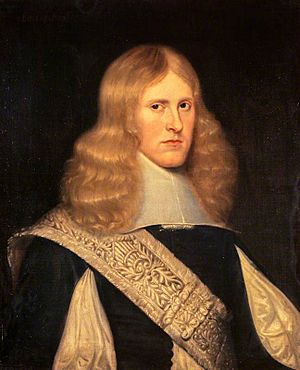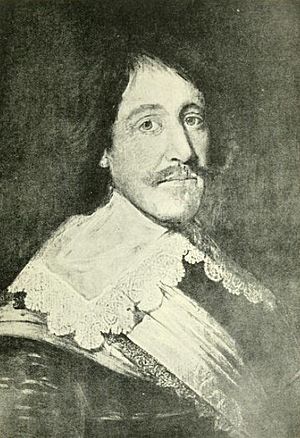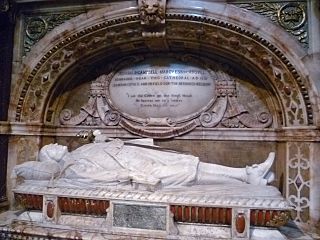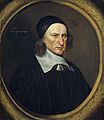Archibald Campbell, 1st Marquess of Argyll facts for kids
Quick facts for kids
The Marquess of Argyll
|
|
|---|---|

The Marquess of Argyll, by David Scougall
|
|
| Born | 7 March 1607 |
| Died | 27 May 1661 (aged 54) Edinburgh, Scotland
|
| Cause of death | Execution |
| Resting place | Kilmun Parish Church |
| Nationality | Scottish |
| Alma mater | University of St Andrews |
| Occupation | Chief of Clan Campbell, politician |
| Title | Marquess of Argyll, 8th Earl of Argyll, member of the Privy Council of Scotland, Assembly of Divines, parliament of 1659 for Aberdeenshire |
| Spouse(s) | Lady Margaret Douglas |
| Children | Archibald Campbell, 9th Earl of Argyll Lord Neill Campbell Lady Anne Campbell Lady Jean Campbell two other daughters |
| Parent(s) | Archibald Campbell, 7th Earl of Argyll Agnes Douglas, Countess of Argyll |
Archibald Campbell, Marquess of Argyll (March 1607 – 27 May 1661) was an important Scottish nobleman and politician. He was the leader of Clan Campbell, a powerful family in Scotland. During the 1640s and 1650s, a time of big conflicts called the Wars of the Three Kingdoms, he was effectively in charge of Scotland's government.
Argyll was a key figure in the Covenanter movement. This group wanted to protect the Presbyterian religion in Scotland. They were against the Stuart kings, who tried to make the Scottish church more like the English church. Argyll is often remembered as the main rival of the royalist general James Graham, 1st Marquess of Montrose.
Contents
Early Life and Family
Archibald Campbell was the oldest son of Archibald Campbell, 7th Earl of Argyll. His mother was Agnes Douglas, Countess of Argyll. He studied at St Andrews University. When his father gave up his Protestant faith, young Archibald, known then as Lord Lorne, took control of the family's lands.
He had great power over Clan Campbell, which included about 20,000 followers. People said he was the most powerful person in Scotland. Argyll was tall and slender, with reddish hair that later turned darker. He had a noticeable squint. People who knew him said he was charming and good at persuading others.
Joining the Covenanter Movement
In 1637, a big religious disagreement started between King Charles I and Scotland. The king wanted Lord Lorne's support. In 1628, he was made a privy councillor. In 1638, the king called him to London, but Argyll warned Charles against his strict church policies. He strongly disagreed with William Laud, the Archbishop of Canterbury.
Because of this, a secret plan was made to cause trouble for Argyll in his home region. This plan involved stirring up the MacDonalds against the Campbells. When his father died in 1638, Argyll became the new Earl. He decided to fully support the Covenanters. They wanted to protect Scotland's religion and freedoms.
Defending Scottish Liberties
Argyll continued to attend meetings of the General Assembly of the Church of Scotland. This was even after the king's representative tried to close it down. The Assembly decided to get rid of Episcopacy, which was the king's preferred church system. Argyll defended their actions to the king.
Argyll gathered his own soldiers and took control of Hamilton's castle in Arran. After a peace agreement, he helped pass a new rule. This rule allowed the Scottish Parliament to choose its own leaders, instead of the king. This was a huge change, giving more power to the Scottish people.
In 1640, when the king tried to stop Parliament, Argyll insisted it should continue. He became a key leader of a committee that managed Scotland's affairs. He also led troops against royalist supporters in some areas, acting strongly against them.
Rivalry with Montrose
Over time, Argyll and James Graham, 1st Marquess of Montrose became strong rivals. Montrose planned to accuse Argyll of disloyalty to the king. But the plan was discovered, and Montrose was put in prison.
When King Charles I visited Scotland, he found he had lost most of his power. He had to agree to many demands. He gave control over important appointments to the Scottish Parliament. In 1641, the king made Argyll a marquess, a very high noble title. There was also an unsuccessful attempt to kidnap Argyll and other leaders, known as The Incident. Argyll helped keep the Scottish leaders united. He also helped form an alliance with the English Parliament in 1643.
Scottish Civil War and English Conflicts
In 1644, Argyll joined the Scottish army that marched into England. He was part of a committee that worked with both kingdoms. But he soon had to return to Scotland to deal with royalist supporters in the Scottish Civil War. He forced the royalist leader Huntly to retreat.
Later, Irish troops landed in Argyll's lands and joined Montrose. Neither Argyll nor Montrose could gain a clear victory over the other. Argyll then went back to Edinburgh. Montrose followed him, forcing Argyll to flee and destroying his lands.
Major Defeats
On 2 February 1645, Montrose surprised Argyll's forces at Inverlochy. Argyll watched from his boat as his troops suffered heavy losses, including 1,500 of his own Campbell clan. He returned to Edinburgh. He was also present at Montrose's big victory at Kilsyth in August, where he managed to escape. Finally, Montrose was defeated at Philiphaugh in September, which was a relief for Argyll.
In 1646, Argyll was sent to talk with the king at Newcastle. The king had surrendered to the Scottish army. Argyll tried to get the king to agree to the demands of the English Parliament. He was also appointed a member of the Assembly of Divines, a group of religious leaders.
Changing Alliances
Argyll had been very successful in protecting Scotland's freedoms and religion. The king's power in Scotland was greatly reduced. But Argyll's influence weakened when the alliance between Scotland and England broke apart. He was against an agreement made in 1647 between King Charles I and the Scots against the English Parliament.
James, Duke of Hamilton led a Scottish army into England, but it was defeated by Cromwell in August 1648. After escaping an attack in September, Argyll joined a group of Covenanters in Edinburgh. With their support, he helped form a new government that welcomed Oliver Cromwell.
Later Life and Execution
The execution of King Charles I in January 1649 shocked everyone in Scotland. After this, Argyll lost control of Scotland's direction. He felt "distracted" and that his efforts were not working.
Argyll supported inviting Charles II to Scotland. He saw Montrose, his old rival, being taken to his execution. When Charles II came to Scotland, he signed the Covenanter agreement. Argyll remained a leader in the government. After a defeat at Dunbar, Charles II kept Argyll's support by promising him a dukedom. On 1 January 1651, Argyll placed the crown on Charles II's head at Scone.
However, Argyll's power was now fading. He strongly opposed, but could not stop, the Scottish army's expedition into England. After Scotland was taken over by the English Commonwealth, Argyll held out in his castle for almost a year. In August 1652, he finally surrendered to the Commonwealth. His political power was gone.
Trial and Death
During a visit to Monck in 1654, Argyll faced many problems with his debts. When he visited London in 1655 to get money owed to him, he was arrested for debt, but soon released. In 1659, Argyll served as a member of Parliament for Aberdeenshire.
When King Charles II returned to power in 1660, Argyll went to meet him. But he was immediately arrested and sent to the Tower of London. He was then sent to Edinburgh for trial, accused of disloyalty to the king. He was found not guilty of being involved in Charles I's death. However, new letters showed he had worked with Cromwell's government, especially in putting down a royalist uprising in 1652.
Because of these letters, he was quickly sentenced to death. He was executed by beheading on a machine called the 'Maiden' on 27 May 1661. His head was placed on a spike at the Tolbooth, where Montrose's head had been before. His body was buried at Kilmun Parish Church. A monument was put up in his memory in St Giles' Church in Edinburgh in 1895.
Works
While he was imprisoned in the Tower of London, he wrote a book called Instructions to a Son (1661). Some of his speeches, including his final words before his execution, were also published.
Family
Argyll married Lady Margaret Douglas. They had two sons, including Archibald Campbell, 9th Earl of Argyll, who became the next Earl. They also had four daughters.
In Fiction
Archibald Campbell, Marquess of Argyll, appears as a character in the novel John Splendid (1898) by Neil Munro.
Images for kids








